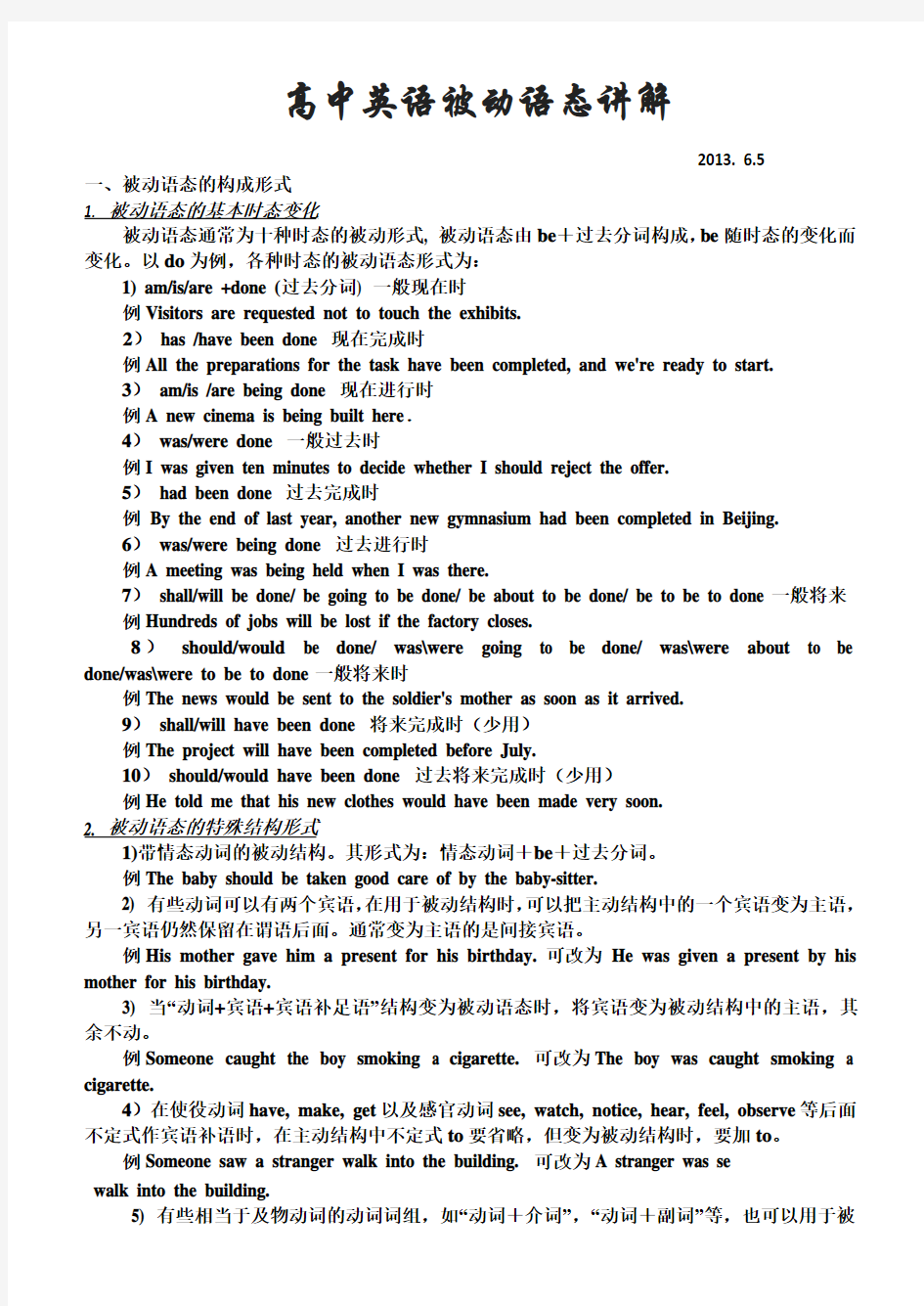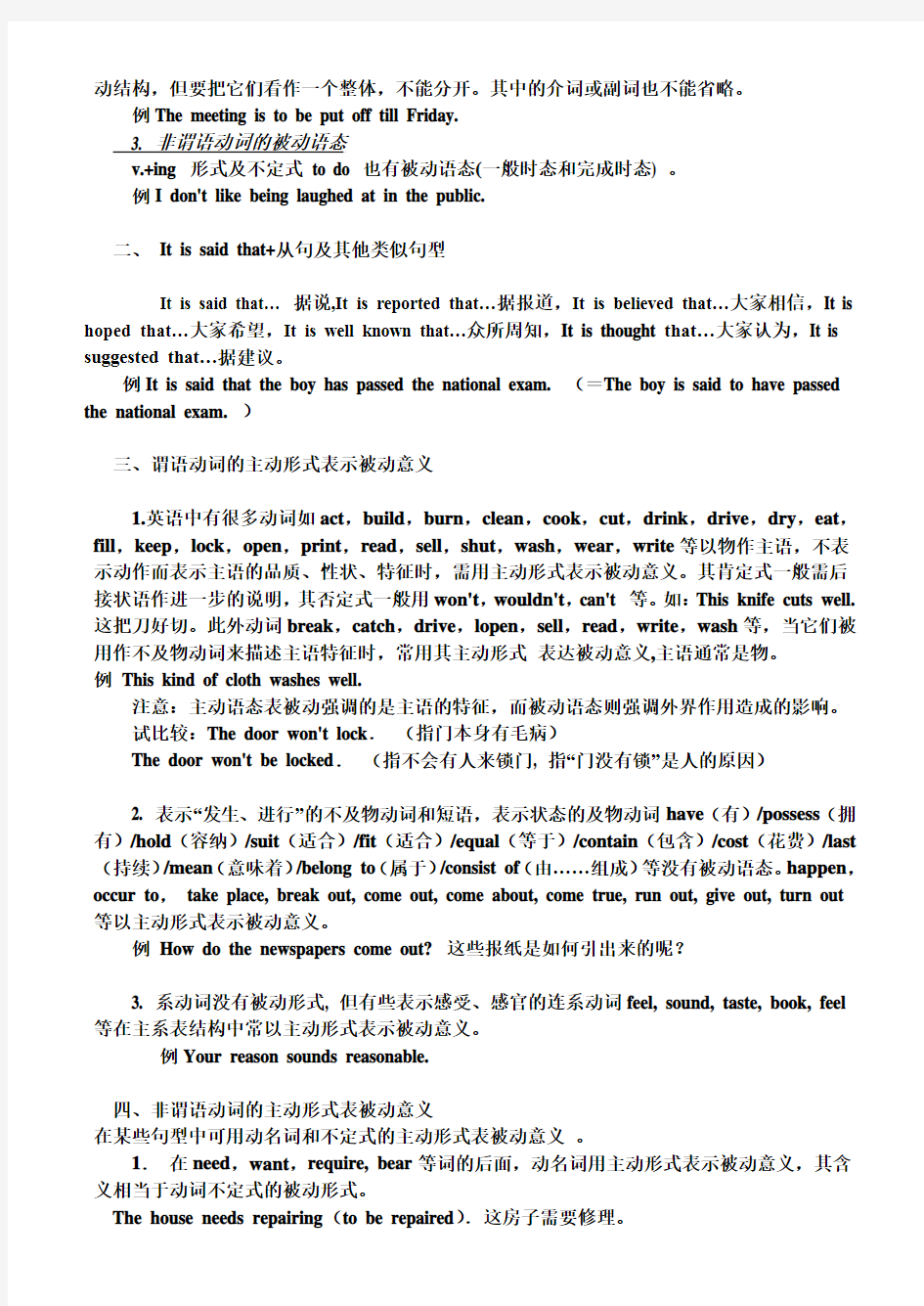被动语态精讲


高中英语被动语态讲解
2013. 6.5
一、被动语态的构成形式
1. 被动语态的基本时态变化
被动语态通常为十种时态的被动形式, 被动语态由be+过去分词构成,be随时态的变化而变化。以do为例,各种时态的被动语态形式为:
1) am/is/are +done (过去分词) 一般现在时
例Visitors are requested not to touch the exhibits.
2)has /have been done 现在完成时
例All the preparations for the task have been completed, and we're ready to start.
3)am/is /are being done 现在进行时
例A new cinema is being built here.
4)was/were done 一般过去时
例I was given ten minutes to decide whether I should reject the offer.
5)had been done 过去完成时
例By the end of last year, another new gymnasium had been completed in Beijing.
6)was/were being done 过去进行时
例A meeting was being held when I was there.
7)shall/will be done/ be going to be done/ be about to be done/ be to be to done一般将来例Hundreds of jobs will be lost if the factory closes.
8)should/would be done/ was\were going to be done/ was\were about to be done/was\were to be to done一般将来时
例The news would be sent to the soldier's mother as soon as it arrived.
9)shall/will have been done 将来完成时(少用)
例The project will have been completed before July.
10)should/would have been done 过去将来完成时(少用)
例He told me that his new clothes would have been made very soon.
2. 被动语态的特殊结构形式
1)带情态动词的被动结构。其形式为:情态动词+be+过去分词。
例The baby should be taken good care of by the baby-sitter.
2) 有些动词可以有两个宾语,在用于被动结构时,可以把主动结构中的一个宾语变为主语,另一宾语仍然保留在谓语后面。通常变为主语的是间接宾语。
例His mother gave him a present for his birthday. 可改为He was given a present by his mother for his birthday.
3) 当“动词+宾语+宾语补足语”结构变为被动语态时,将宾语变为被动结构中的主语,其余不动。
例Someone caught the boy smoking a cigarette. 可改为The boy was caught smoking a cigarette.
4)在使役动词have, make, get以及感官动词see, watch, notice, hear, feel, observe等后面不定式作宾语补语时,在主动结构中不定式to要省略,但变为被动结构时,要加to。
例Someone saw a stranger walk into the building. 可改为A stranger was se
walk into the building.
5) 有些相当于及物动词的动词词组,如“动词+介词”,“动词+副词”等,也可以用于被
动结构,但要把它们看作一个整体,不能分开。其中的介词或副词也不能省略。
例The meeting is to be put off till Friday.
3. 非谓语动词的被动语态
v.+ing 形式及不定式to do 也有被动语态(一般时态和完成时态) 。
例I don't like being laughed at in the public.
二、It is said that+从句及其他类似句型
It is said that… 据说,It is reported that…据报道,It is believed that…大家相信,It is hoped that…大家希望,It is well known that…众所周知,It is thought that…大家认为,It is suggested that…据建议。
例It is said that the boy has passed the national exam. (=The boy is said to have passed the national exam. )
三、谓语动词的主动形式表示被动意义
1.英语中有很多动词如act,build,burn,clean,cook,cut,drink,drive,dry,eat,fill,keep,lock,open,print,read,sell,shut,wash,wear,write等以物作主语,不表示动作而表示主语的品质、性状、特征时,需用主动形式表示被动意义。其肯定式一般需后接状语作进一步的说明,其否定式一般用won't,wouldn't,can't 等。如:This knife cuts well.这把刀好切。此外动词break,catch,drive,lopen,sell,read,write,wash等,当它们被用作不及物动词来描述主语特征时,常用其主动形式表达被动意义,主语通常是物。
例This kind of cloth washes well.
注意:主动语态表被动强调的是主语的特征,而被动语态则强调外界作用造成的影响。
试比较:The door won't lock.(指门本身有毛病)
The door won't be locked.(指不会有人来锁门, 指“门没有锁”是人的原因)
2. 表示“发生、进行”的不及物动词和短语,表示状态的及物动词have(有)/possess(拥有)/hold(容纳)/suit(适合)/fit(适合)/equal(等于)/contain(包含)/cost(花费)/last (持续)/mean(意味着)/belong to(属于)/consist of(由……组成)等没有被动语态。happen,occur to,take place, break out, come out, come about, come true, run out, give out, turn out 等以主动形式表示被动意义。
例How do the newspapers come out? 这些报纸是如何引出来的呢?
3. 系动词没有被动形式, 但有些表示感受、感官的连系动词feel, sound, taste, book, feel 等在主系表结构中常以主动形式表示被动意义。
例Your reason sounds reasonable.
四、非谓语动词的主动形式表被动意义
在某些句型中可用动名词和不定式的主动形式表被动意义。
1.在need,want,require, bear等词的后面,动名词用主动形式表示被动意义,其含义相当于动词不定式的被动形式。
The house needs repairing(to be repaired).这房子需要修理。
2.形容词worth后面跟动名词的主动形式表示被动含义,但不能跟动词不定式;而worthy后面跟动词不定式的被动形式。
例The picture-book is well worth reading.(=The picture-book is very worthy to be read.)
3. 动词不定式在名词后面作定语,不定式和名词之间有动宾关系时,又和句中另一名词或代词构成主谓关系, 不定式的主动形式表示被动含义。
例I have a lot of things to do this afternoon.(to do与things是动宾关系,与I是主谓关系。) 试比较:I’ll go to the post office. Do you have a letter to be posted? ( 此处用不定式的被动语态作定语表明you不是post动作的执行者。)
4. 在某些“形容词+不定式”做表语或宾语补足语的结构中,句子的主语或宾语又是动词不定式的逻辑宾语时,这时常用不定式的主动形式表达被动意义。这些形容词有nice,easy,fit,hard,difficult,important,impossible,pleasant,interesting等。
例This problem is difficult to work out .(可看作to work out省略了for me).
5.在too… to…结构中,不定式前面可加逻辑主语,所以应用主动形式表示被动意义。
例This book is too expensive (for me) to buy.
6. 在there be…句型中,当动词不定式修饰名词作定语时,不定式用主动式作定语,重点在人,用被动形式作定语,重点在物。
例There is no time to lose(to be lost).(用to lose可看成for us to lose;用to be lost,谁lost time不明确。)
7. 在be to do结构中的一些不定式通常应用主动表主动, 被动表被动。然而,由于古英语的影响,下列动词rent,blame,let等仍用不定式的主动形式表示被动意义。
例Who is to blame for starting the fire?
五、介词in, on, under等+名词构成介词短语表被动意义
表示方位的介词与含动作意义的名词合用,含被动之义,其意义相当于该名词相应动词的被动形式,名词前一般不用冠词。
1. “under +名词”结构,表示“某事在进行中”。常见的有:under control(受控制), under treatment(在治疗中), under repair(在修理中), under discussion(在讨论中), under construction(在施工中)。
例The building is under construction( is being constructed).
2.“beyond+名词”结构,“出乎……胜过……、范围、限度”。常见的有:beyond belief (令人难以置信),beyond one’s reach(鞭长莫及),beyond one’s control(无法控制),beyond our hope.我们的成功始料不及。
3.“above+名词”结构, 表示“(品质、行为、能力等) 超过……、高于……”。
4.“for+名词”结构,表示“适于……、为着……”。如:for sale(出售), for rent(出租5.“in+名词”结构,表示“在……过程中或范围内”常见的有:in print(在印刷中),in sight(在视野范围内),等。例The book is not yet in print.(=is not yet printed) 6.“on+名词”结构, 表示“在从事…… 中”。常见的有:on sale(出售),on show(展出)7.“out of+名词”结构;表示“超出…… 之外“,常见的有:out of control (控制不了),out of
sight (超出视线之外),out of one’s reach(够不着), out of fashion(流行)等。
8.“within+名词”结构,“在……内、不超过……”。
例He took two days off within the teacher's permission.
六、被动语态与系表结构的区别
当“be+过去分词”作被动语态时表示主语承受的动作;作系表结构时表示主语的特点或所处的状态时,be后面的过去分词是表语,相当于形容词。其区分办法如下:
1.如果强调动作或句中有介词by引导出动作的执行者,该句一般为被动语态,否则为系表结构。
例The glass is broken.(系表结构)The glass was broken by the boy.(被动语态)2.如果句中有地点、频率或时间状语时,一般为被动语态。
例The door is locked.(系表结构)The door hasalready/just been locked.(被动语态)3.被动语态除用于一般时态和完成时态外,还可以用于其他各种时态,而系表结构中的系动词be只有一般时态和完成时态。
例The machine is being repaired.
七、被动语态与高考
( ) 1. In some parts of the world, tea ___ with milk and sugar.
A. is serving
B. is served
C. serves
D. served
( )2.This is Ted’s phone. We miss him a lot. He ___ trying to save a child in the earthquake.
A. killed
B. is killed
C. was killed
D. was killing
( )3. ---- Have you moved into the new house?
---- Not yet, the rooms _____.
A. are being painted
B. are painting
C. are painted
D. are being painting
( )4. When and where to go for the on-salary holiday ___ yet.
A. are not decided
B. have not been decided
C. is not being decided
D. has not been decided
( )5. The manager entered the office and was happy to learn that four-fifths of the tickets ___.
A. was booked
B. had been booked
C. were booked
D. have been booked
( )6. Having a trip abroad is certainly good for the old couple, but it remains
_____ whether they will enjoy it.
A. to see
B. to be seen
C. seeing
D. seen
( )7. While shopping, people sometimes can’t help ___ into buying something they don’t really need.
A. to persuaded
B. persuading
C. being persuaded
D. be persuaded
( )8. I feel it is your husband who ___ for the spoiled child.
A. is to blame
B. is going to blame
C. is to be blamed
D. should blame
( )9. The palace caught fire three times in the last century,and little of the
original building ______ now.
A. remains B.is remained C.is remaining D.has been remained
( )10. The roast duck which Mr.and Mrs.White prepared ______ well.
A.sold B.had been sold C.was sold D.would sell
